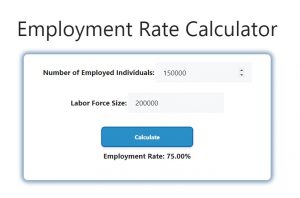About Employment Rate Calculator (Formula)
The Employment Rate Calculator is a powerful tool used to assess the health of a labor market by determining the percentage of employed individuals within the labor force. Understanding employment rates is crucial for policymakers, economists, and businesses as it reflects economic conditions, helps in workforce planning, and guides decision-making. This article will delve into how to use the Employment Rate Calculator, provide an illustrative example, and address common questions related to employment rate calculations.
Formula
The formula for calculating the employment rate (ER) is:
ER = (E / LF) * 100
Where:
- ER represents the employment rate as a percentage.
- E is the number of employed individuals.
- LF is the total labor force, which includes both employed and unemployed individuals.
How to Use
- Collect Required Data: To use the Employment Rate Calculator, gather the following data:
- The number of employed individuals (E).
- The total labor force (LF), which includes both employed and unemployed individuals.
- Input Values into the Formula: Substitute the gathered values into the employment rate formula.
- Perform the Calculation: Execute the calculation to determine the employment rate.
- Analyze the Results: Use the calculated employment rate to assess labor market conditions, compare with previous data, or make informed decisions.
Example
Let’s walk through an example to illustrate how to calculate the employment rate.
- Given Data:
- Number of employed individuals (E) = 150,000
- Total labor force (LF) = 200,000
Step 1: Input Values into the Formula
Using the formula ER = (E / LF) * 100:
Step 2: Calculate ER
ER = (150,000 / 200,000) * 100
ER = 0.75 * 100
ER = 75%
In this example, the employment rate is 75%, indicating that 75% of the labor force is currently employed.

FAQs
- What is the employment rate?
The employment rate measures the percentage of employed individuals within the total labor force. - Why is the employment rate important?
It helps assess the economic health of a region, informs policy decisions, and aids businesses in workforce planning. - What is included in the labor force?
The labor force includes all individuals who are employed or actively seeking employment. - How can I improve the employment rate in my area?
Strategies may include job creation initiatives, vocational training programs, and supporting local businesses. - What does a low employment rate indicate?
A low employment rate may signal economic challenges, such as a recession or high unemployment rates. - Is the employment rate the same as the unemployment rate?
No, the employment rate measures employed individuals, while the unemployment rate measures those actively seeking work but not employed. - How often are employment rates updated?
Employment rates are typically reported monthly or quarterly, depending on the country or region. - Can the employment rate be influenced by seasonal jobs?
Yes, seasonal employment can cause fluctuations in the employment rate throughout the year. - What demographic factors affect employment rates?
Factors include age, education level, industry, and geographic location. - How do government policies impact the employment rate?
Government policies, such as tax incentives or job training programs, can create jobs and improve employment rates. - What is a healthy employment rate?
A healthy employment rate varies by region but is generally considered to be above 60-70%. - How do I calculate unemployment rates?
The unemployment rate is calculated by dividing the number of unemployed individuals by the labor force and multiplying by 100. - What is the difference between the labor force participation rate and the employment rate?
The labor force participation rate measures the proportion of the working-age population that is part of the labor force, while the employment rate focuses only on those employed. - How can businesses use employment rate data?
Businesses can use this data for workforce planning, evaluating market conditions, and identifying potential talent pools. - What sources provide employment rate statistics?
Government labor departments, statistical agencies, and economic research organizations often publish employment statistics. - Can employment rates differ by industry?
Yes, employment rates can vary significantly across different industries based on demand and economic conditions. - How does economic growth affect employment rates?
Economic growth typically leads to higher employment rates as businesses expand and hire more workers. - What are some limitations of using the employment rate?
The employment rate does not account for underemployment or individuals who have given up looking for work. - How can employment rates be affected by global events?
Global events such as pandemics, economic crises, or geopolitical changes can significantly impact employment rates. - Where can I find historical employment rate data?
Historical data can be found in government publications, academic studies, and labor market research reports.
Conclusion
The Employment Rate Calculator is a vital tool for understanding the dynamics of the labor market. By accurately calculating the employment rate, stakeholders can make informed decisions that impact economic strategies, workforce development, and overall labor market health. Understanding the employment rate helps policymakers and businesses address challenges and seize opportunities in the ever-changing job landscape. With the knowledge gained from this article, users can effectively apply the Employment Rate Calculator in their analyses and decision-making processes.